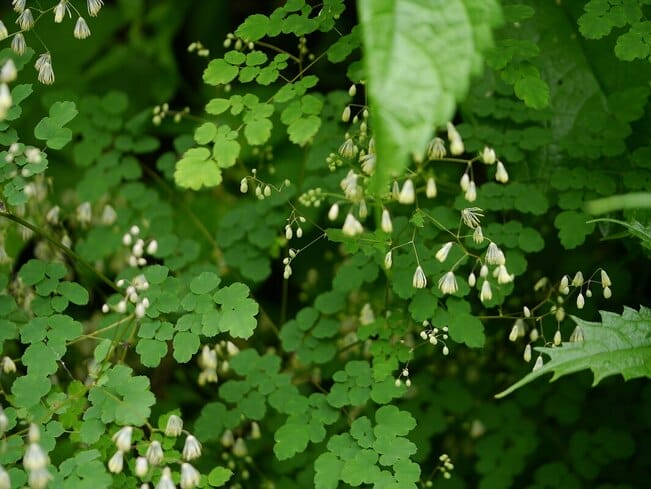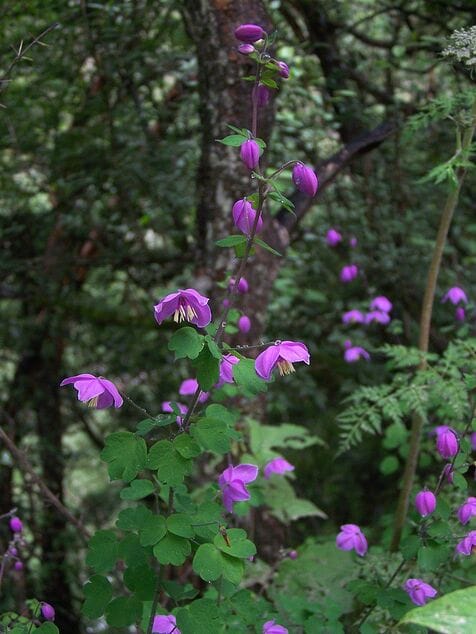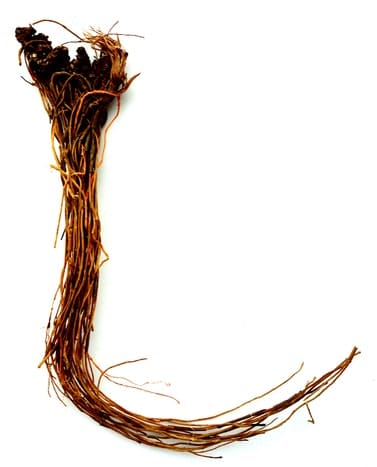Thalictrum, Meadow Rue
Asian Meadow Rue, Leafy Meadow Rue, Gold ThreadJin Si Ma Wei Lian or Tang Song Cao (TCM)
Pitaranga (Ayurveda)
Piaranga (Unani)
Mamira (along with Coptis, Unani)
Babunay Almasakin (Arabic)
Sngo Sprin (Tibet)
Sngo Sprin Lo Ma Che Ba (Tibet, T. cultratum)
Sngo Sprin Lo Ma Chung Ba (Tibet, T. reniforme)
 Thalictrum foliolosum
Thalictrum foliolosum(Photo by Dinesh Valke) (Wikimedia)
 Thalictrum reniforme
Thalictrum reniforme(Photo by Woudloper) (Wikimedia)
 Thalictrum root Ma Wei Lian (Adam, 2017)
Thalictrum root Ma Wei Lian (Adam, 2017)Botanical name:
Thalictrum spp.
Primary species are used:
- Thalictrum glandulosissimum–Goldenthread Meadow Rue (TCM)
- Thalictrum foliolosum–Manyleaf Meadow Rue (syn. T. falconeri, T. dalingo) (TCM, Unani)
- Thalictrum baicalense–Baikal Meadow Rue (TCM)
- Thalictrum flavum–Maidenhair Meadow Rue (TCM)
- Thalictrum cultratum–Highland Meadow Rue (TCM)
- Thalictrum minus–Lesser Meadow Rue (TCM, Mongolia, Iran)
In Tibet, several species of Thalictrum supply Sngo sprin including T. virgatum, T. reniforme.
Salmon also listed several varieties of Meadow Rue, noting similar uses to the above-mentioned species.
Various Thalictrum species are also used in other parts of the World.
Parts used:
Root
Salmon noted the leaves have similar effects, but are weaker.
Temperature & Taste:
Cold, dry. Bitter (considered Warm in Unani)
Constituents:
Alkaloids: berberine, jatrorrhizine, palmatine, thalrugosidine, thalrugosaminine, thalisopine (thaligosine), thalirugidine, thalirugine, 8-oxyberberine (berlambine), noroxyhydrastinine, thalicarpine, thalidasine
Uses:
1. Clears Heat and Damp: (TCM, Tibet, Unani)
-Diarrhea, Dysentery (TCM, Unani)
-Jaundice (TCM, Salmon, Duke)
-Hepatitis
-Fungal Infections, internally and topically
-also for excess menstrual bleeding from Heat (Tibet)
2. Clears Heat, Resists Poison: (TCM, Tibet, Unani)
-Influenza, Common Cold with Fever
-Lung Heat Cough, acute Lung inflammation, Sore Throat
-Fever, Children’s Fever, Intermittent Fevers, Epidemic Fevers
-Malaria, Typhoid Fever, Cholera, Measles
-sore and red eyes
-Toxic Sores, Abscesses, Itchy skin diseases
-Poisoning (Tibet)
-leaf and flower have also been boiled for Fever, and as a wash to boils, wounds, skin diseases (Nepal)
3. Stimulates Digestion:
-as a bitter digestive tonic like other bitters (Unani)
–atonic dyspepsia, peptic ulcers
4. Externally:
-root paste is applied topically for Sores, Boils, Abscesses
-as a wash for itchy skin diseases
-eyewash for red, sores eyes
-used for Bedsores in Iran
-collyrium to clear the Eyesight (Unani)
-root ash applied to clear eyesight
-inflammations and hard swellings, applied topically
-snuff of the root for coryza toothache
-snuff for Epilepsy (Salmon)
-root paste applied to the temples and forehead for headache
Dose:
Powder: 500mg–2 grams
Decoction: 6–15 grams
Tincture (1 in 8): 20–30 drops
Fluid Extract (1:1): 5–20 drops
Comment:
T. glandulosissimum is used similarly to Coptis Huang Lian in TCM. In Unani medicine, the drug Mamira is supplied variously by T. foliosum and Coptis teeta. This shows the close usage with Coptis species in different systems.
Substitute:
1. Coptis Huang Lian; in Tibet, Coptis is regarded as a superior type of the Thalictrum group.
2. Gentian root (India)
3. Rhubarb (Unani); Thalictrum has been used as a substitute for Rhubarb.
4. Curcuma caesia root bark (Unani)
5. Carica papaya seeds (Unani)
6. Cocos nucifera (Unani)
Correctives:
1. Black Pepper
2. Ginger
Main Combinations:
1. Diarrhea, Dysentery:
i. Thalictrum with Coptis Huang Lian, charred Rhubarb root
ii. Thalictrum with Red Earth
2. Jaundice, Thalictrum with Artemisia Yin Chen Hao
3. Cholera, taken with Rose water after each bowel motion (Unani)
4. Thalictrum root and Datura seed as a pasteto Eczema (India)
Major Formulas:
Cautions:
None noted
–”no reports on the toxicity of this herb“
Main Preparations used:
GENERAL / REVIEW:
–Ethnobotany, botany, phytochemistry and ethnopharmacology of the genus Thalictrum L. (Ranunculaceae): A review.
–Thalictrum foliolosum: A lesser unexplored medicinal herb from the Himalayan region as a source of valuable benzyl isoquinoline alkaloids.
–Natural products from medicinal plants: non-alkaloidal natural constituents of the Thalictrum species.
–Ethnopharmacological investigations on Thalictrum plants in China.
ANTI-BACTERIAL:
–Altitudinal variation of berberine, total phenolics and flavonoid content in Thalictrum foliolosum and their correlation with antimicrobial and antioxidant activities.
–Isolation and characterization of three benzylisoquinoline alkaloids from Thalictrum minus L. and their antibacterial activity against bovine mastitis.
ANTI-VIRAL:
–[A new antiviral isoquinoline alkaloid from Thalictrum glandulosissimum].
–In vitro anti-influenza virus activity of isoquinoline alkaloids from thalictrum species.
MALARIA:
–Antiplasmodial potential of Thalictrum foliolosum (Ranunculaceae) against lethal murine malaria.
–Preliminary in vitro antiplasmodial activity of Aristolochia griffithii and Thalictrum foliolosum DC extracts against malaria parasite Plasmodium falciparum.
ANTIOXIDANT:
–Altitudinal variation of berberine, total phenolics and flavonoid content in Thalictrum foliolosum and their correlation with antimicrobial and antioxidant activities.
ACUTE LUNG INJURY:
–Thalictrum minus L. ameliorates particulate matter-induced acute lung injury in mice.
–The protective effects of Thalictrum minus L. on lipopolysaccharide-induced acute lung injury.
TUBERCULOSIS:
–Bioactives from medicinal herb against bedaquiline resistant tuberculosis: removing the dark clouds from the horizon.
HYPOTENSIVE:
–Alkaloids of Thalictrum XXVII. New hypotensive aporphine-benzylisoquinoline derived dimeric alkaloids from Thalictrum minus race B.
–Alkaloids of Thalictrum XXVI. New hypotensive and other alkaloids from Thalictrum minus race B.
JAUNDICE:
–Assessment of phytochemicals, antioxidants and in-silico molecular dynamic simulation of plant derived potential inhibitory activity of Thalictrum foliolosum DC. and Cordia dichotoma G. Forst. against jaundice.
DIABETES:
–Hernandezine, a natural herbal alkaloid, ameliorates type 2 diabetes by activating AMPK in two mouse models.
CANCER:
–Cytotoxic isoquinoline alkaloids from the roots of Thalictrum foliolosum.
–Determination of a novel anticancer AMPK activator hernandezine in rat plasma and tissues with a validated UHPLC-MS/MS method: Application to pharmacokinetics and tissue distribution study.
–Two new benzylisoquinoline alkaloids from Thalictrum foliolosum and their antioxidant and in vitro antiproliferative properties.
–[Anti-tumor effect of hernandezine and other components extracted from Thalictrum glandulosissimum].
LIVER:
–Inhibitory Effect of Hernandezine on the Proliferation of Hepatocellular Carcinoma.
PANCREATIC:
–Hernandezine induces autophagic cell death in human pancreatic cancer cells via activation of the ROS/AMPK signaling pathway.
